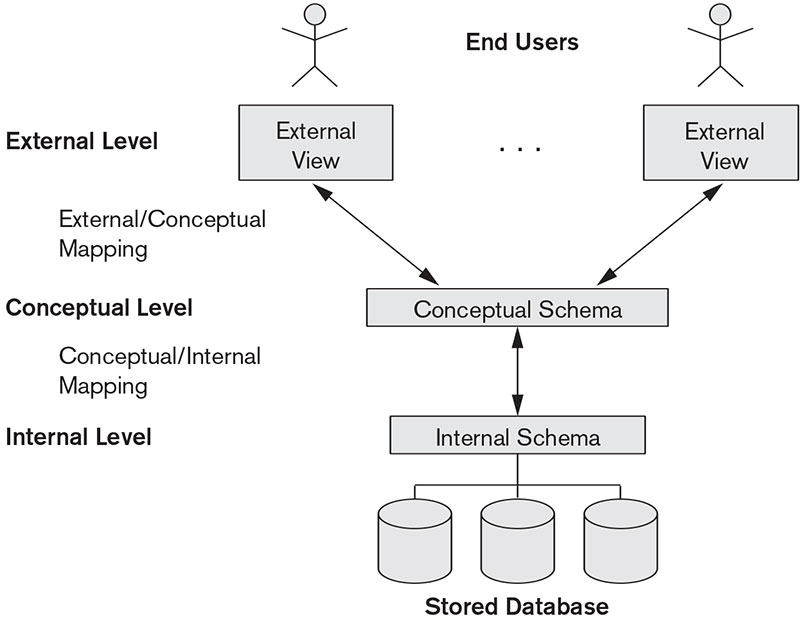Three-Schema Architecture
The Three Levels of Abstraction
1. External Schema (View Level)
This is the highest level of abstraction, defining how specific users or applications see the data. An external schema presents a tailored "view" that shows only the relevant parts of the database, simplifying interaction and enhancing security. A single database can have many external schemas.
- Who uses it: End-users, application developers.
- Example: A university's course registration app might have a view that shows a student their enrolled courses and grades but hides faculty salary information.
2. Conceptual Schema (Logical Level)
The conceptual schema is a unified, logical representation of the entire database. It describes all the entities (e.g., tables), attributes (e.g., columns), relationships, and integrity constraints. This level hides the physical storage details, focusing on the overall data model. There is only one conceptual schema per database.
- Who uses it: Database designers, data architects.
- Example: An Entity-Relationship Diagram (ERD) defining
Students,Courses, andEnrollmentstables, along with their primary and foreign key relationships.
3. Internal Schema (Physical Level)
This schema describes how the data is physically stored on hardware. It defines the low-level details like file structures, indexes (e.g., B-trees), data compression, and storage access paths. Its goal is to optimize performance and storage efficiency. There is only one internal schema per database.
- Who uses it: Database administrators (DBAs), infrastructure engineers.
- Example: Specifying that the
Studentstable is stored on a high-speed SSD and has an index on theStudentIDcolumn for fast lookups.
Data Independence: The Core Benefit
The separation of these schemas provides two crucial types of data independence:
- Logical Data Independence: The ability to change the conceptual schema without having to change the external schemas. For instance, you could add a new
PhoneNumbercolumn to theStudentstable without breaking an existing application that doesn't use that column. - Physical Data Independence: The ability to change the internal schema without having to change the conceptual schema. For example, a DBA could move the database files to a different storage device or change the indexing strategy to improve performance, and neither the applications nor the logical data model would be affected.
How It Connects: Mappings
- External-Conceptual Mapping: Translates requests from a user's view (external schema) into operations on the logical model (conceptual schema).
- Conceptual-Internal Mapping: Translates requests on the logical model into operations on the physical data storage (internal schema).
The DBMS uses these mappings to find the physical data a user requests and to ensure that all operations are consistent with the defined rules and constraints.

Relevance in Modern Systems
While originally conceived for relational databases, the principles of the three-schema architecture are more relevant than ever in today's complex technology landscape.
- Cloud Databases (e.g., AWS RDS, Azure SQL): You define the logical schema (tables, columns), while the cloud provider manages the entire internal/physical schema for you.
- Object-Relational Mappers (ORMs): These tools create an object-oriented external view for developers, mapping it to the conceptual schema of a relational database.
- APIs and Microservices: An API often serves as an external schema, providing a stable contract for data access while the underlying conceptual or physical database can be changed independently.